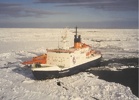 I like Google Earth. I like looking down on my neighbours to see what’s going on behind their shelter belts, and because I like monitoring what’s going on at the poles, I have the National Snow & Ice Data Centre’s overlay switched on most of the time. It shows current sea ice extent, snow cover and so on. But when I swoop over Antarctica, the underlying images provided by Google are rather disappointing – low resolution and distorted. I was therefore very pleased to discover that a collaboration between NASA, the US Geological Survey, the National Science Foundation and the British Antarctic Survey has created a new map of the continent based on Landsat imagery. From NASA’s press release:
I like Google Earth. I like looking down on my neighbours to see what’s going on behind their shelter belts, and because I like monitoring what’s going on at the poles, I have the National Snow & Ice Data Centre’s overlay switched on most of the time. It shows current sea ice extent, snow cover and so on. But when I swoop over Antarctica, the underlying images provided by Google are rather disappointing – low resolution and distorted. I was therefore very pleased to discover that a collaboration between NASA, the US Geological Survey, the National Science Foundation and the British Antarctic Survey has created a new map of the continent based on Landsat imagery. From NASA’s press release:
The map is a realistic, nearly cloudless satellite view of the continent at a resolution 10 times greater than ever before with images captured by the NASA-built Landsat 7 satellite. With the unprecedented ability to see features half the size of a basketball court, the mosaic offers the most geographically accurate, true-color, high-resolution views of Antarctica possible.
You can play with the map at the USGS site, but the interface is rather clunky. However, there are hints that the new map will be available for Google Earth before long. Can’t wait….



